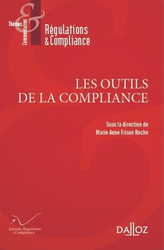BENZONI, Laurent🕴️ et DEFFAINS, Bruno🕴️
📝Approche économique des outils de la Compliance: finalité, mesure, effectivité de la Compliance "subie" et "choisie", in 🕴️M.-A. Frison-Roche (ed.), 📕Les outils de la Compliance
pour lire cette présentation en français ↗️cliquer sur le drapeau français

► Full Reference: L. Benzoni and B. Deffains, "Approche économique des outils de la Compliance: finalité, mesure, effectivité de la Compliance "subie" et "choisie"" ("Economic approach of Compliance Tools: purpose, measurement, efficiency of Compliance "undergone" and "chose""), in M.-A. Frison-Roche (ed.), Les outils de la Compliance, coll. "Régulations & Compliance", Journal of Regulation & Compliance (JoRC) and Dalloz, 2021, pp. 39-50.
____
📕read a general presentation of the book, Les outils de la Compliance, in which this article is published.
____
► Summary of the article (done by the Journal of Regulation & Compliance): Authors refer to economic analysis of Law general works to say that firms can have an interest in showing by anticipation that they comply to Law in a long term strategy of reputation and reliability, this internalization imposed by Compliance and transformed by the Corporate Social Responsibility benefiting to the firm and its choice being related thus to rationality and not to emotion.
Thus the mechanisms of Compliance stop to be "imposed", the firm just minimizing the perspective of a future sanction, to be "chosen", the firm taking freely a responsibility, for example in the environnemental or human rights protection fields, going beyond legal requirements (what "monumental goals" corresponds to, which goes beyond the interest of partners and of the legal obligation). The investment calculus is more difficult for the second one, hardly measurable, than for the first one (probability calculus). The loi PACTE leaves room to a "chosen Compliance" but we badly measure its effectivity: we wait case law in its use of obligation Law. Moreover, if the status of "entreprise à mission" is adopted, the goal becomes statutorily binding and the governance of the firm must be modified for the internal control of means implemented. But, supposing that companies only search competitive avantages, it is only about, through this general interest service, conquering new benefits, the lucrative purpose of chosen Compliance showing the liberal character of Compliance.
The authors underline that this "chosen Compliance" implies evaluation and analysis tools different from those used for "imposed Compliance". In "imposed Compliance", it is about, taking back Gary Becker's works, considering risk aversion, the firm calculating its likelihood to be punished or not with regards to the gain obtained with the infringement (dependent on those who conceive Law to design it according to the model of incentives) and to the cost generated by the intern Compliance tools. The authors underline that the uncertainty of legal solutions, and there the importance of soft law, makes these calculus harder and that rationality of agents is not total, the perspective of being punished being rejected in itself while the respect of the rule is rather natural, the firms being so "honest" (theory of cognitive bias) and not wanting to be singled out (name and shame). Behavioral economics thus privileges "imposed Compliance", beyond cost-advantage calculus.
In the case of "chosen Compliance", it is competition economics which draws solutions, because the firm imposes to itself a constraint to get a competitive advantage of it, in that these self-imposed constraints meet societal demands, external (for example, environnement) or internal (for example, cohesion into the firm). The external gains are the positive image of the firm with regards to the reputation of its competitors. These investments lose their efficacy because all the firms adopt the same, what by the way transform these practices in common legal norms. Internal gains are measured in organizational sociology by the adhesion to the firm's project, reducing the internal inefficiency in a superior to investment profit.
________
comments are disabled for this article